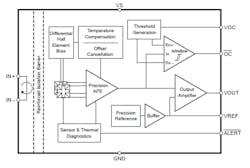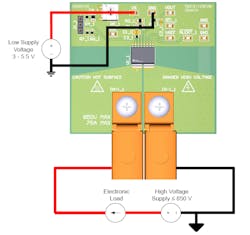Accurate, Isolated Hall-Effect Current-Sensor IC Includes Critical Shunt
Sensing current, especially in higher-voltage settings, is often a challenge. It’s generally more difficult than voltage sensing, as it is usually “invasive” and requires “breaking” into the current-carrying conductor. A sense resistor (usually on the high side) and differential amplifier is a standard solution, but there are often issues of galvanic (ohmic) isolation, which is needed for system performance as well as regulatory standards.
Other options include non-contact transformers as well as Hall-effect devices. The latter is attractive in many cases, but needs an external shunt component, and the stability and accuracy of that “simple” component as well as the Hall sensor itself has an impact on overall performance.
New Isolated Hall-Effect Sensor
To address this dilemma, Texas Instruments introduced the TMCS1123 galvanically isolated Hall-effect current sensor. It offers design simplicity and accuracy for high-voltage systems (Fig. 1) and is claimed to be industry’s most accurate such device.
The device features what TI also said are the industry’s highest reinforced isolation and highest accuracy specifications over lifetime and temperature (the traditional downside of Hall-effect sensors is their high drift over lifetime). Applications include solar-energy installations, motor control, electric-vehicle charging, power supplies, and industrial AC-DC installations. Users can set an overcurrent threshold alarm value using external resistors, and the overcurrent condition is indicated by an open-drain active-low output.
In the TMCS1123, an output voltage proportional to the input current is provided with excellent linearity and low drift at all sensitivity options (five such suffix options are available, ranging from 25 to 150 mV/A). Precision signal-conditioning circuitry with built-in drift compensation provides total error over temperature and lifetime under 1.75% maximum with no system-level calibration, or less than 1% maximum total error with a one-time room temperature calibration (including both lifetime and temperature drift).
How Does the Current Sensor Work?
In operation, the bidirectional AC or unidirectional DC input current to be sensed flows through an internal conductor, generating a magnetic field measured by integrated on-chip Hall-effect sensors. The input current passes through the isolated high-voltage side of the package leadframe and then into and out of the IN+ and IN– pins. The current flowing through the package generates a magnetic field that’s proportional to the input current, which is measured by the integrated, on-chip, galvanically isolated, precision Hall sensor.
Due to the electrostatic shielding on the Hall sensor die, only the magnetic field generated by the input current is measured, thus limiting input-voltage switching from passing through to the circuitry. This configuration allows for direct measurement of currents with high-voltage transients without signal distortion on the current-sensor output. Core-less construction eliminates the need for magnetic concentrators, while differential Hall sensors reject interference from stray external magnetic fields.
The low conductor resistance increases measurable current ranges up to ±96 A while minimizing power loss and easing thermal-dissipation requirements. The insulation is capable of withstanding 5000 V RMS, and when coupled with minimum 8.1-mm creepage and clearance, provides up to 1100 VDC reliable lifetime reinforced-working voltage. TI’s anticipated safety-related certifications for this device include the UL 1577 Component Recognition Program and IEC/CB 62368-1.
Integrated shielding enables excellent common-mode rejection and transient immunity. It also features a maximum sensitivity error of ±0.75% with 50 ppm/°C drift over temperature and ±0.5% drift over lifetime. Low propagation delay of 600 ns and bandwidth of 250 kHz enable faster control loops while keeping noise low to help increase system efficiency.
Hands-on support for assessing the TMCS1123 is available via the TMCS1123xEVM evaluation module (Fig. 2).
The TMCS1123 35-page datasheet covers basic operation and applications, and it includes extensive explanation and analysis of errors, drifts, scaling, and other real-world factors to substantiate and quantify the accuracy performance. The companion 26-page TMCS1123xEVM User Manual presents operation and connection details as well as a schematic, reference PCB layouts, and a complete bill of materials (BOM).
It's available in a 10.3- × 10.3-mm, 10-lead small-outline (SOIC) package and operates from a single 3- to 5.5-V supply. Pricing for the TMCS1123 starts at $2.37 (1,000-unit quantities) while the TMCS1123EVM is $49.99.
References
“Simplifying high-voltage sensing with Hall-effect current sensors”
“Current Sensing With Isolated Magnetic Hall-Effect Current Sensors”
“4 key current-sensing design trends that are powering electrification”


